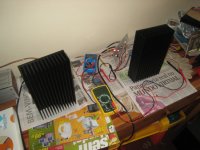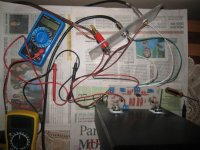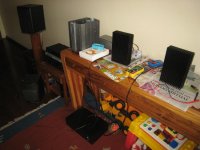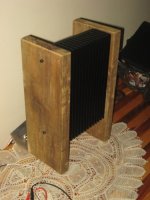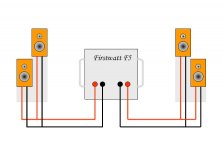Well, now I feel really silly... I actually *have* two multimeters, but never thought to use them at the same time to do the adjustment.... Now it has been pointed out it seems kind of obvious....
I'll have another go and let you all know what happens.
Thanks
Nigel
I'll have another go and let you all know what happens.
Thanks
Nigel
Yes, I use one for looking at output offset and the other for looking
at the DC across one of the Source resistors. When the offset is 0,
the other side will have the same current. This is particularly useful
if you have adjusted one of the Source resistors for lowest thd.
😎
at the DC across one of the Source resistors. When the offset is 0,
the other side will have the same current. This is particularly useful
if you have adjusted one of the Source resistors for lowest thd.
😎
IT WORKS!
The title says it all, doesn't it? I took the afternoon off work and did the adjustment again, with the thermistors still in the circuit as before. I slowly raised the bias (with two multimeters, as everyone suggested) to about 0.54V across R11 and R12, over about an hour, at which point the heatsinks appeared to be more or less stable at 50 degrees C, and DC offset was less than 5mV (Seemed to fluctuate a bit, which I gather is normal. Ambient temp was about 25-26 degrees). I then hooked up speakers and so forth to see how the sound was. Initial reaction v. positive. I tried some piano, a little Marilyn Horne, and some string quartet beofre switching to Charles Mingus. After a while I started getting complaints about volume from - well, from just about everyone, really, so I turned everything off to let things cool down - I would like to check the bias with the amp cold next, and follow it as things warm up without any further adjustment.
Someone up above asked about hum/hiss from the PSU. Well, I have not tried it with my most sensitive speakers, but with my old B&W CDM2's (which if I recall correctly are about 87db/1W) I can hear a slight hum (but almost no hiss) if I put my ear almost against the speaker with the (passive) preamp at full volume. The volume of the hum varies with the volume control on the preamp, which suggests to me that it is not primarily from the power amp (or its PSU) at all. And it is, in any event, very slight. Far lower than the residual hum/noise from the Hiraga Le Classe A which the F5 is intended to replace.
A little later I will post photos of the test setup.
This is how I did it (following suggestions o Babowana and Tea-Bag above), except I have not " adjusted one of the Source resistors for lowest thd". In fact, once the DC offset is at zero the multimeter gives slightly different voltages across the two resistors, presumably due to slight difference in resistor values. I suppose I could tweak this without too much trouble - I am thinking of testing a pile of resistors to match values. Is it worth it? I also don't know how to test for thd, and I don't have a scope. Is it possible without one?
Anyhow, many thanks to all.
Regards
Nigel
The title says it all, doesn't it? I took the afternoon off work and did the adjustment again, with the thermistors still in the circuit as before. I slowly raised the bias (with two multimeters, as everyone suggested) to about 0.54V across R11 and R12, over about an hour, at which point the heatsinks appeared to be more or less stable at 50 degrees C, and DC offset was less than 5mV (Seemed to fluctuate a bit, which I gather is normal. Ambient temp was about 25-26 degrees). I then hooked up speakers and so forth to see how the sound was. Initial reaction v. positive. I tried some piano, a little Marilyn Horne, and some string quartet beofre switching to Charles Mingus. After a while I started getting complaints about volume from - well, from just about everyone, really, so I turned everything off to let things cool down - I would like to check the bias with the amp cold next, and follow it as things warm up without any further adjustment.
Someone up above asked about hum/hiss from the PSU. Well, I have not tried it with my most sensitive speakers, but with my old B&W CDM2's (which if I recall correctly are about 87db/1W) I can hear a slight hum (but almost no hiss) if I put my ear almost against the speaker with the (passive) preamp at full volume. The volume of the hum varies with the volume control on the preamp, which suggests to me that it is not primarily from the power amp (or its PSU) at all. And it is, in any event, very slight. Far lower than the residual hum/noise from the Hiraga Le Classe A which the F5 is intended to replace.
A little later I will post photos of the test setup.
Nelson Pass said:Yes, I use one for looking at output offset and the other for looking
at the DC across one of the Source resistors. When the offset is 0,
the other side will have the same current. This is particularly useful
if you have adjusted one of the Source resistors for lowest thd.
😎
This is how I did it (following suggestions o Babowana and Tea-Bag above), except I have not " adjusted one of the Source resistors for lowest thd". In fact, once the DC offset is at zero the multimeter gives slightly different voltages across the two resistors, presumably due to slight difference in resistor values. I suppose I could tweak this without too much trouble - I am thinking of testing a pile of resistors to match values. Is it worth it? I also don't know how to test for thd, and I don't have a scope. Is it possible without one?
Anyhow, many thanks to all.
Regards
Nigel
I would just leave it alone, and play the music, forget resistor matching.
I would keep an eye on bias as the article states, and if you change the enclosure of the amp itself.
I would keep an eye on bias as the article states, and if you change the enclosure of the amp itself.
I'm posting a photo below of the test setup.
I'm guessing that's an expensive piece of kit my wife won't let me have. (On a slightly off-topic note, does anyone know of any linux software that would measure thd using line-in on the soundcard? I realise it probably wouldn't be fantastic, but at least interesting to play with?)
Maybe you're right. I certainly *will* be changing the enclosure, since they don't exist yet. (The design I have in mind will ventilate the heatsinks better than just standing them on end, as at present). So for the time being it's just a matter of fiddling about and learning a little, I hope.
Cheers
Nigel
Nelson Pass said:You have to have a distortion analyzer that goes down to .001%
to play with that.
😎
I'm guessing that's an expensive piece of kit my wife won't let me have. (On a slightly off-topic note, does anyone know of any linux software that would measure thd using line-in on the soundcard? I realise it probably wouldn't be fantastic, but at least interesting to play with?)
Tea-Bag said:I would just leave it alone, and play the music, forget resistor matching.
I would keep an eye on bias as the article states, and if you change the enclosure of the amp itself.
Maybe you're right. I certainly *will* be changing the enclosure, since they don't exist yet. (The design I have in mind will ventilate the heatsinks better than just standing them on end, as at present). So for the time being it's just a matter of fiddling about and learning a little, I hope.
Cheers
Nigel
Attachments
njepitt said:I'm guessing that's an expensive piece of kit my wife won't let me have. (On a slightly off-topic note, does anyone know of any linux software that would measure thd using line-in on the soundcard? I realise it probably wouldn't be fantastic, but at least interesting to play with?)
There are some good threads in the Solid State forum on this. You
might have to boot Windows for most of them 🙁
njepitt said:on the side
Very pretty side-TABLE.
And very bad manners to use it for other than flowers and table lamps, your spouse must be the forgiving breed.

jacco vermeulen said:
Very pretty side-TABLE.
And very bad manners to use it for other than flowers and table lamps, your spouse must be the forgiving breed.
Well, forgiving enough to look at it temporarily.... Permanently is another matter altogether..... 🙂
nigel-
Nice work -- It will be interesting to hear what you think of the sound.
I built my F5 with 2n4416A and a 2n5116 --I had them in my junk box.
JJ
Nice work -- It will be interesting to hear what you think of the sound.
I built my F5 with 2n4416A and a 2n5116 --I had them in my junk box.
JJ
jupiterjune said:I built my F5 with 2n4416A and a 2n5116 --I had them in my junk box. JJ
Did you have to make any changes to the DC setting of the JFETs and is noise an issue with the types that you used?
Here is a progress report, for those who are interested. Overall I am very pleased.
Each heatsink has been mounted between two vertical hardwood supports as shown in the photo below. The wood is "ipe", a brazilian tropical hardwood a good deal denser than water, which is perhaps not important in an amplifier except to counterbalance the weight of the heatsink. I have made no attempt to sand and finish the wood yet, so please don't think of the photo as showing a final version - it's there to illustrate some of the remarks I'll make below. Since the heatsinks are held four inches off the table there is ample space for air to enter below. They are held away from the wood by washers, which minimises contact betwen hot metal and wood. (Possibly I will change these for something a bit thicker to try to raise ventilation further still. I have spent a good deal of time today adjusting bias (still with the thermistors in the circuit) and listening to music - here are some remarks and a few questions.
I have tried it out using source from an Airport Express (.wav and .flac formats via linux software, not iTunes....) through a Creek P43 preamp, in both passive and active modes, and the B1 preamp I made which I usually use in the office setup. The speakers are B&W CDM2s (13 years old), although I tried one or two things using FE127e monopoles (from the diyaudio reference thread, and which also usually fit in the office setup).
1. Since the B&Ws are not that sensitive (87db/W), using either of the passive preamps left the system a bit short of juice. I tried the monopoles, which are 91 db/W, and the problem was "solved", except that the size of the living room showed up the inadequacies of the speakers in the bass range. (This is not a problem in my very small office). In any event, the Creek active preamp clearly matched the rest of the system best. (I imagine this combo simply gives more gain...). This raises the future prospect of either new speakers, or perhaps a B3 preamp when the circuit is out (either one being diy, of course... and either being appealing...) but the little Creek preamp will do fine for now.
2. I was pleasantly surprised by the bass response in the system. The last few minutes of Mahler 2 (with the organ and so on) were much more solid than with any of my other diy amps, or my old Creek 5050 integrated. I didn't expect this - have other people found this? Or maybe it is just an unexpected synergy with the speakers? (Or just in my head?)
3. The hum in the system is very low. With the FE127es I can hear a hum, although no apparent hiss or buzz, with my ear close to the speaker. When I have time and patience I will try putting in the thermistor to separate the signal and safety earths in the PSU, which seems to me the most likely culprit. I shoiuld point out, though, that of all the amplifiers in the house this is the quietest in this regard, and in all cases the hum/noise is inaudible in normal listening. (The Creek 5050 is noticeably worse than the F5, but possibly this is due to an external step-down transformer needed because it is 110v, not 220v).
4. I am little disappointed that the heatsinks reach 56 degrees C (with ambient at 27 or so, and bias at 0.56v across R11 and R12, which is just a little lower than the 0.6v recommended in the article). I am measuring this with a probe connected to the multimeter, pushed up between the fins on the heatsink so that it is directly behind one of the mosfets. I had hoped to have a temp at 50 or so. In the long F5 thread a temp of 50 is mentioned several times - is this measured in an equivalent way to what I am doing? Obviously a hand on the heatsink (as suggested) is going to sense the temp at the tips of the fins, which is probably a little less. On the other hand 56 degrees isn't too bad - am I worrying about nothing? (An extreme solution would be to rebuild the amps, cutting the heatsinks in two and remounting horizontally somehow. Not too keen on this, for obvious reasons...)
Well, there it is... As always, I am most grateful for remarks/criticisms/comments...
Cheers
Nigel
Each heatsink has been mounted between two vertical hardwood supports as shown in the photo below. The wood is "ipe", a brazilian tropical hardwood a good deal denser than water, which is perhaps not important in an amplifier except to counterbalance the weight of the heatsink. I have made no attempt to sand and finish the wood yet, so please don't think of the photo as showing a final version - it's there to illustrate some of the remarks I'll make below. Since the heatsinks are held four inches off the table there is ample space for air to enter below. They are held away from the wood by washers, which minimises contact betwen hot metal and wood. (Possibly I will change these for something a bit thicker to try to raise ventilation further still. I have spent a good deal of time today adjusting bias (still with the thermistors in the circuit) and listening to music - here are some remarks and a few questions.
I have tried it out using source from an Airport Express (.wav and .flac formats via linux software, not iTunes....) through a Creek P43 preamp, in both passive and active modes, and the B1 preamp I made which I usually use in the office setup. The speakers are B&W CDM2s (13 years old), although I tried one or two things using FE127e monopoles (from the diyaudio reference thread, and which also usually fit in the office setup).
1. Since the B&Ws are not that sensitive (87db/W), using either of the passive preamps left the system a bit short of juice. I tried the monopoles, which are 91 db/W, and the problem was "solved", except that the size of the living room showed up the inadequacies of the speakers in the bass range. (This is not a problem in my very small office). In any event, the Creek active preamp clearly matched the rest of the system best. (I imagine this combo simply gives more gain...). This raises the future prospect of either new speakers, or perhaps a B3 preamp when the circuit is out (either one being diy, of course... and either being appealing...) but the little Creek preamp will do fine for now.
2. I was pleasantly surprised by the bass response in the system. The last few minutes of Mahler 2 (with the organ and so on) were much more solid than with any of my other diy amps, or my old Creek 5050 integrated. I didn't expect this - have other people found this? Or maybe it is just an unexpected synergy with the speakers? (Or just in my head?)
3. The hum in the system is very low. With the FE127es I can hear a hum, although no apparent hiss or buzz, with my ear close to the speaker. When I have time and patience I will try putting in the thermistor to separate the signal and safety earths in the PSU, which seems to me the most likely culprit. I shoiuld point out, though, that of all the amplifiers in the house this is the quietest in this regard, and in all cases the hum/noise is inaudible in normal listening. (The Creek 5050 is noticeably worse than the F5, but possibly this is due to an external step-down transformer needed because it is 110v, not 220v).
4. I am little disappointed that the heatsinks reach 56 degrees C (with ambient at 27 or so, and bias at 0.56v across R11 and R12, which is just a little lower than the 0.6v recommended in the article). I am measuring this with a probe connected to the multimeter, pushed up between the fins on the heatsink so that it is directly behind one of the mosfets. I had hoped to have a temp at 50 or so. In the long F5 thread a temp of 50 is mentioned several times - is this measured in an equivalent way to what I am doing? Obviously a hand on the heatsink (as suggested) is going to sense the temp at the tips of the fins, which is probably a little less. On the other hand 56 degrees isn't too bad - am I worrying about nothing? (An extreme solution would be to rebuild the amps, cutting the heatsinks in two and remounting horizontally somehow. Not too keen on this, for obvious reasons...)
Well, there it is... As always, I am most grateful for remarks/criticisms/comments...
Cheers
Nigel
Attachments
njepitt said:
2. I was pleasantly surprised by the bass response in the system. The last few minutes of Mahler 2 (with the organ and so on) were much more solid than with any of my other diy amps, or my old Creek 5050 integrated. I didn't expect this - have other people found this? Or maybe it is just an unexpected synergy with the speakers? (Or just in my head?)
I also get clean and solid base from my F5.
You know? These days I let my F5 drive four speakers (see the sketch). F5 doesn't feel any burden, and drives them very well. They are power hungry babies, 8ohms 84dB each.
>>🙂<<
Attachments
Babowana said:
I also get clean and solid base from my F5.
You know? These days I let my F5 drive four speakers (see the sketch). F5 doesn't feel any burden, and drives them very well. They are power hungry babies, 8ohms 84dB each.
>>🙂<<
Wow. I'm impressed. It never occurred to me to hook up more than two speakers. Do I understand correctly that you have simply wired them two each into the F5 outputs? And these are not separated by crossovers or something?
Cheers
Nigel
56C is not too bad, considering your heatsinks are too tall to be efficient.
....and 56C is nothing to worry about. I personally like to keep my heatsinks below 45C, but that's just for the very long term stability.
Your biggest issue would be that small children would go "ouch, maaaamyyyy", which really isn't an issue, as it keeps those little vandals from exploring the possibilities of messing with your amp 😀
Magura 🙂
....and 56C is nothing to worry about. I personally like to keep my heatsinks below 45C, but that's just for the very long term stability.
Your biggest issue would be that small children would go "ouch, maaaamyyyy", which really isn't an issue, as it keeps those little vandals from exploring the possibilities of messing with your amp 😀
Magura 🙂
Magura said:56C is not too bad, considering your heatsinks are too tall to be efficient.
....and 56C is nothing to worry about. I personally like to keep my heatsinks below 45C, but that's just for the very long term stability.
Your biggest issue would be that small children would go "ouch, maaaamyyyy", which really isn't an issue, as it keeps those little vandals from exploring the possibilities of messing with your amp 😀
Magura 🙂
Well, 56C is what it'll have to be. I read on another thread just now that 56C *close* to the mosfets is lower than Nelson accepts on one of the zens, so it can't be all that bad. Long term stability worries me a little, but there you go....
Small children are quite an issue in a house with four of them, but the one that is most trouble has already learned what "don't touch - hot!" means...
(I *told* her not to touch my soldering iron, and she just looked at me and did it to defy me!! 😱)
Cheers
Nigel
njepitt said:
Do I understand correctly that you have simply wired them two each into the F5 outputs?
Yes, two are just paralled at each channel simply by wires.
Am I mad . . . ?
>>🙂<<
Babowana said:
Yes, two are just paralled at each channel simply by wires.
Am I mad . . . ?
>>🙂<<
Not if it works... 😎
Nigel
- Status
- Not open for further replies.
- Home
- Amplifiers
- Pass Labs
- Planning an F5 build - some beginner questions
